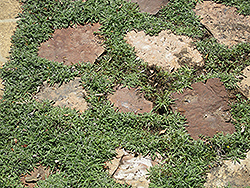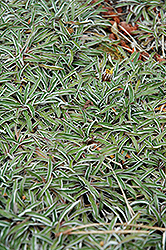PLANT FINDER
Height: 3 inches
Spread: 14 inches
Sunlight:
![]()
![]()
Hardiness Zone: (annual)
Description:
An interesting slow spreading groundcover with long narrow leaves that are gray-green on top, white and tomentos underneath; the leaves curl along the edges giving a variegated appearance; grows rapidly with irrigation; but is very drought tolerant
Ornamental Features
Silver Carpet's attractive tomentose narrow leaves remain grayish green in color with curious white undersides throughout the year on a plant with a spreading habit of growth. It features tiny yellow daisy flowers along the stems in mid summer.
Landscape Attributes
Silver Carpet is a dense herbaceous annual with a ground-hugging habit of growth. It brings an extremely fine and delicate texture to the garden composition and should be used to full effect.
This is a relatively low maintenance plant, and usually looks its best without pruning, although it will tolerate pruning. It has no significant negative characteristics.
Silver Carpet is recommended for the following landscape applications;
- Mass Planting
- General Garden Use
- Groundcover
Planting & Growing
Silver Carpet will grow to be only 3 inches tall at maturity, with a spread of 14 inches. Its foliage tends to remain low and dense right to the ground. Although it's not a true annual, this slow-growing plant can be expected to behave as an annual in our climate if left outdoors over the winter, usually needing replacement the following year. As such, gardeners should take into consideration that it will perform differently than it would in its native habitat.
This plant does best in full sun to partial shade. It is very adaptable to both dry and moist growing conditions, but will not tolerate any standing water. It is considered to be drought-tolerant, and thus makes an ideal choice for a low-water garden or xeriscape application. It is not particular as to soil type or pH, and is able to handle environmental salt. It is somewhat tolerant of urban pollution. This species is not originally from North America. It can be propagated by division.






